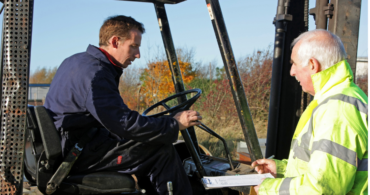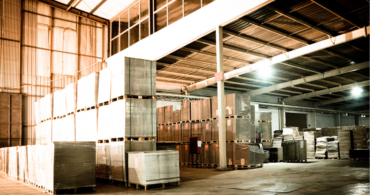Whether it’s a small-scale operation or a sprawling distribution center, selecting the right warehouse racking system is essential to the success of any warehouse operation.
The difference between a successful warehouse operation and one that lags behind often depends on how that organization utilizes its storage space. One of the most important decisions for any storage facility is finding and implementing the best warehouse racking systems that suit the operations’ specific needs.
There are many different types of racking in warehouse operations, and some fit a specific business’s needs better than others. However, each is crafted to optimize space, streamline inventory management and improve operational efficiency.
The 6 popular racking systems for warehouses
Selective pallet racking
The selective pallet rack is currently the most common warehouse racking system. This type of storage is highly versatile and can accommodate a wide range of pallet sizes, shapes and weights, making them ideal for facilities with diverse inventory. Each level of the rack can be adjusted to accommodate items of different sizes.
One of the primary advantages of selective pallet racking is that each shelf is a single pallet deep, meaning that the pallets are readily accessible. This is why many organizations utilize a selective pallet racking system in warehouse operations that employ the first-in, first-out (FIFO) inventory management method, where the oldest inventory is used or sold first.
A drawback of a selective pallet warehouse racking system is that it typically has lower storage density than other racking options. Also, the need for aisles between each rack increases the footprint of the system, potentially requiring more warehouse space for less storage ability.
Double-deep pallet racking
A double-deep pallet rack is a selective pallet racking system warehouse variation that enables two pallets to be stored in the same slot, one behind the other. The advantage is that this configuration effectively doubles the storage capacity compared to standard selective pallet racking systems. By storing pallets two-deep, double-deep pallet racking optimizes floor space while still providing relatively easy access to stored goods.
However, the double-deep warehouse racking system design still has the same space utilization drawback as selective pallet racking. In addition, retrieving the pallets stored at the back of the rack may require specialized handling equipment, such as reach trucks or specialized forklift attachments.
Pallet flow racking
Pallet flow racks use inclined roller tracks and utilize gravity to move pallets from the higher end of the tracks toward the unloading end. Businesses typically use these types of racking system in warehouse operations that employ first-in, first-out inventory management.
An advantage of a pallet flow warehouse racking system is its high storage potential. Because pallet flow rack systems transport pallets forward, the shelves can extend far deeper than typical storage options. Also, depending on the warehouse’s layout, pallet flow racking can increase efficiency by reducing picking times and making it easier to find the correct items needed to fulfill orders.
However, the upkeep of this warehousing racking system is much more intensive than the previously mentioned storage options. Pallet flow rack systems require regular maintenance to prevent issues such as jamming or product hang-ups. It also has lower weight capacities, which may limit the system’s ability to store heavier products.
Cantilever pallet racking
you’ve ever been to the lumber department of a home improvement store, you’ve seen cantilever racking. This warehouse racking system has no shelves, just a series of load-bearing arms to house long products, such as pipes, lumber, metal sheets, etc.
The benefit of cantilever pallet racking is that it can store products that other types of racking in warehouse operations cannot accommodate due to their size, shape or weight. Also, many cantilever pallet rack systems feature adjustable arms that can be repositioned to accommodate different types of products or changes in inventory.
However, installing and maintaining cantilever pallet rack systems can be more complex and labor-intensive compared to standard pallet racking systems. Also, these systems typically have lower load capacities compared to traditional types of warehouse racking systems.
Drive-in pallet racking
Drive-in warehousing racking systems are comprised of sturdy, vertical frames with horizontal load beams. Forklifts literally drive into the racks to load and unload cargo. These structures have no shelves. Instead, pallets are stored one after the other directly on the load beams.
The major advantage of this warehousing racking system is its high storage capacity. Drive-in pallet rack systems eliminate the need for aisles between every rack, maximizing available floor space. Because only the pallet at the front of each lane is directly accessible, drive-in pallet racks are best for businesses that utilize a last-in, first-out inventory management system.
The downside to a drive-in warehouse racking system is that it is difficult to access specific pallets, particularly those stored in the middle or rear of the rack rows. For this reason, drive-in racks are typically used in warehouses that store non-perishable goods and inventory with no “use by” date.
Drive-through pallet racking
A drive-through warehouse racking system design is like a drive-in pallet rack, except forklifts enter from one side and exit through the other. Typically, pallets are loaded on one side of the rack and retrieved from the opposite side.
A significant advantage of drive-through racking systems for warehouses is that it can be configured for either first-in, first-out or last-in, first-out inventory management systems. This flexibility fits a warehouse’s specific needs and requirements and allows them to quickly change those practices if needed. Also, like drive-in pallet rack systems, drive-through racks optimize floor space utilization by eliminating the need for aisles between every row.
However, there is some inefficiency in drive-through warehousing racking systems because the entry and exit points at both ends require additional space. This can result in slightly reduced storage capacity and wider aisle widths.
Once you land on the best warehouse racking system for your business, you’ll need your forklifts and other industrial equipment running at peak performance to keep that inventory moving. That’s where Texas Motive Solutions can help. We provide the best forklift batteries and accessories for your operation. We also offer a complimentary forklift fleet performance analysis to optimize the performance of your forklift fleet. Please call us at (888) 316-2459 or fill out this form to learn about our services and discover everything that we can do for you.


